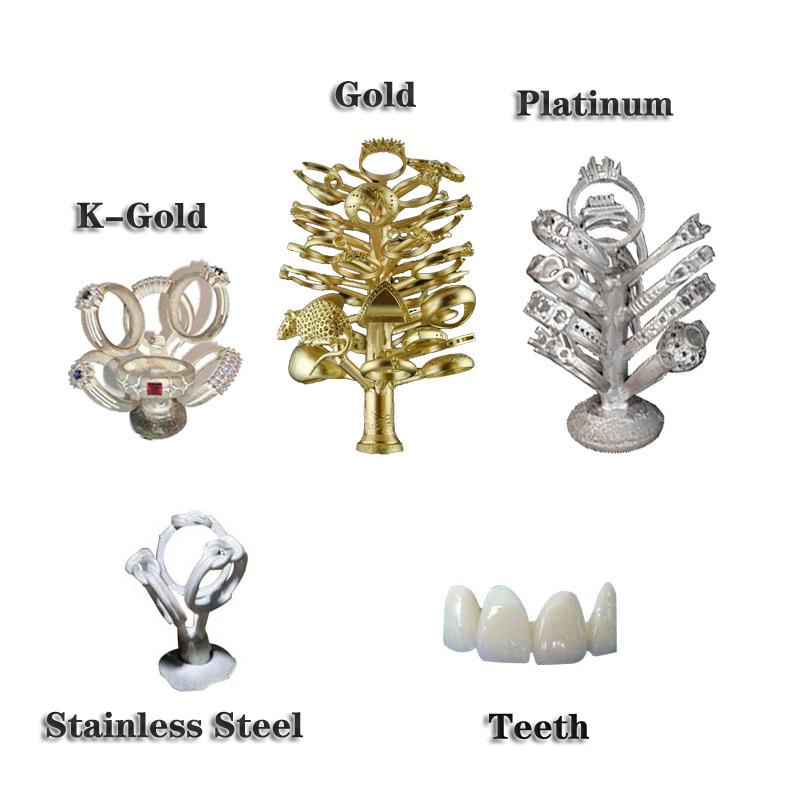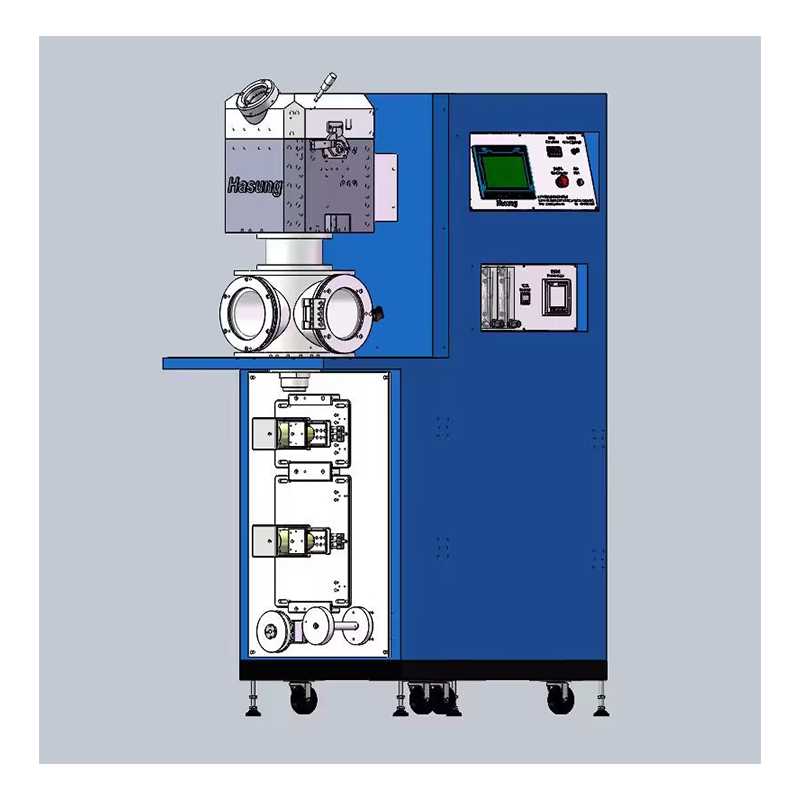
Tilting Vacuum Pressure Casting Machine for Platinum Palladium Gold Silver Steel
Features
Intelligent jewellery vacuum tilting pressure casting system is specially designed by Shenzhen Hasung Precious Metals Equipment Co. , Ltd, we produce precious metals casting and melting equipment with first class quality in China.
Using high-frequency heating technology, automatic frequency tracking and multiple protection technologies, it can be melted in a short time, energy saving and environmental protection, and high work efficiency.
The MC2 to MC4 are extremely versatile casting machines suitable for a wide range of applications, and a number of options that were considered mutually incompatible up to now. Thus, while the MC series was originally designed as a high-temperature casting system for casting steel, palladium, platinum etc. (max. 2,100° C), large flasks also make it suitable for economically producing castings in gold, silver, copper, and other materials.
The machine combines a dual-chamber differential pressure system with a tilting mechanism. The casting process is achieved by rotating the entire melting casting unit by 90°. One benefit of the tilting system is the use of economically priced graphite or ceramic crucibles (without holes and sealing rods). These tend to have a longer service life. Some alloys, such as copper beryllium, quickly cause crucibles with holes and sealing rods to become untight and therefore useless. For this reason, many jewellers have so far processed such alloys only in open systems. But this means they can’t choose to optimise the process with overpressure or vacuum.
With the MC series, A vacuum can be produced in the melting chamber and the casting chamber to avoid oxidation processes during melting and air pockets in the casting mould. The flask is automatically pressed against the melting chamber for casting, this makes it possible to switch to overpressure during casting for better mould filling. Melting chamber comes with positive pressure, casting chamber comes with negative pressure with vacuum.
Hasung Vacuum Machine Compare To Other Companies
1. It's a Big different. the other tilting type vacuum castig system by other companies in China are equipped with only one chamber, all pressure and vacuum are mixed inside.
2. When it's needed for large capacity casting for stainless steel, platinum and gold, Hasung MC series fullfil most of customers' wishes.
3. Hasung's original accessories are imported from Japan and Germany.
4. New generator system controlled via Mitsubishi PLC display. A completely new generation of generator and control systems is present in the MC series. Operation is simple and safe. All parameters, can be individually set and saved to ensure that recurring castings always produce consistent results.
Technical Parameters
| Model No. | HS-MC1 | HS-MC2 | HS-MC5 |
| Voltage | 380V, 50/60Hz, 3 phases | ||
| Power Supply | 15KW | 15KW | 30KW |
| Max. Temperature | 2100°C | ||
| Temp Accuracy | ±1°C | ||
| Temperature Detector | Infrared pyrometer | ||
| Capacity (Pt) | 1kg | 2kg | 5kg (SS) / 10kg (Pt) |
| Max. Flask size | 5"x6" | 5"x8" | Customized |
| Application | Platinum, Palladium, Stainless steel, Gold, silver, copper and other alloys | ||
| Operation method | One-key operation to complete the entire process, POKA YOKE foolproof system | ||
| Control System | 7" Taiwan Weinview PLC intelligent control system | ||
| Shielding Gas | Nitrogen/Argon | ||
| Cooling type | Running Water or Water chiller (Sold separately) | ||
| Dimensions | 600x550x1050mm | 650x550x1280mm | 680x600x1480mm |
| Weight | approx. 160kg | approx. 200kg | approx. 250kg |
Product Display


Title: The complex process of platinum casting: a closer look at its output
Platinum casting is a complex and intricate process that has been used for centuries to create stunning jewelry and other precious objects. This casting method involves the use of platinum, a rare and valuable metal known for its durability and lustrous appearance. In this blog we will take a closer look at the platinum casting process and explore the incredible output produced by this meticulous technique.
The platinum casting process begins with the making of a wax model, which is the basis for the final piece. Skilled craftsmen carefully carve the wax to create the desired design, paying close attention to every detail and intricacy. Once the wax model is complete, it is wrapped in a plaster-like material to form the mold. The mold is then heated to remove the wax, leaving a cavity with the exact shape of the desired part.
Next, the molten platinum is carefully poured into the mold, filling the cavity and taking on the exact shape of the original wax model. This requires a high level of skill and precision, as platinum has a high melting point and must be handled with extreme care. Once the platinum cools and solidifies, the mold is carefully pulled apart to reveal the newly cast parts.
The output of the platinum casting process is truly impressive. The resulting pieces exhibit a level of detail and sophistication unmatched by other casting methods. Platinum's durability and strength make it ideal for fine jewelry, as it can withstand the rigors of everyday wear while maintaining its stunning appearance.
One of the most striking results of platinum casting is the creation of beautiful engagement and wedding rings. Platinum has the intricate ability to mold and form to create stunning designs that are timeless and long-lasting. The lustrous finish of platinum adds a touch of elegance to these special pieces, making it a popular choice for couples looking for a symbol of everlasting love and commitment.
In addition to jewelry, platinum casting is used to create a variety of other items, including decorative items, religious artifacts, and even components for electronic devices. Platinum’s versatility allows the creation of intricate and detailed pieces that are both functional and visually stunning.
The output of the platinum casting process is not only visually stunning, but also of significant value. Platinum is a precious metal with a high market value, making it a sought-after material for manufacturing luxury goods. Meticulous craftsmanship and attention to detail in the platinum casting process make platinum cast pieces not only beautiful but coveted.
In summary, the platinum casting process is a remarkable technology that produces products of exceptional beauty and value. The intricate process of creating the mold, pouring the molten platinum and displaying the final piece requires a high level of skill and precision. The resulting products, whether jewelry, decorations or other items, showcase platinum's unparalleled beauty and durability. This is truly a testament to the artistry and craftsmanship that goes into creating these stunning pieces.

Platinum Casting Process: Steps and Benefits of Using Hasung Platinum Casting Machine
Platinum is a highly sought-after metal in the jewelry industry due to its rarity, durability, and lustrous appearance. The process of casting platinum requires precision and expertise to ensure the creation of high-quality jewelry pieces. In this article, we will explore the steps involved in the platinum casting process and why choosing a Hasung platinum casting machine can significantly benefit jewelry manufacturers.
Platinum casting process
The platinum casting process involves several complex steps that transform raw platinum into fine jewelry pieces. These steps require specialized equipment and skilled workmanship to achieve the desired results. The following are the key steps involved in the platinum casting process:
1. Design and Model Creation: The process starts with designing and creating a model of the desired jewelry piece. This can be done using computer-aided design (CAD) software or prototyping by hand.
2. Mold Making: Once the model is finalized, a mold is created to replicate the design in wax. This step is crucial as it determines the accuracy and detail of the final piece.
3. Wax Injection: The wax model is then injected into the mold to create an exact replica of the jewelry piece. This wax pattern will serve as the basis for the platinum casting process.
4. Wax Tree Assembly: Assemble multiple wax patterns onto a wax tree to create molds for platinum castings.
5. Flask and Burn: Place the wax tree in a flask and subject the entire assembly to a high-temperature burn process. This process eliminates the wax and leaves a cavity in the mold ready for platinum casting.
6. Platinum casting: Use a special tilting induction casting machine to fill molten platinum into the prepared mold. The platinum solidifies within the mold, taking the shape of the original wax pattern.
7. Finishing and Polishing: Once the platinum has cooled and solidified, the jewelry pieces are removed from the molds and undergo various finishing processes, including polishing, to achieve the desired luster and surface texture.
Why Choose Hasung Platinum Induction Vacuum Casting Machine
Hasung is a renowned casting machine manufacturer known for its advanced technology and precision engineering. When it comes to platinum casting, choosing the right equipment is critical to achieving excellent results. Here are some compelling reasons why jewelry manufacturers should consider using a Hasung platinum casting machine:
1. Advanced technology: Hasung platinum casting machines are equipped with advanced features to ensure precise control of the casting process. This includes temperature regulation, vacuum casting and programmable settings for different platinum alloys.
2. Consistent Results: Hasung machines are designed to provide consistent and high-quality casting results, minimizing the risk of flaws or blemishes in the final jewelry piece. This reliability is crucial to meeting the stringent standards of the luxury jewelry market.
3. Efficiency and Productivity: The efficiency of Hasung platinum casting machines enables faster production cycles, allowing jewelry manufacturers to meet demand without compromising on quality. The machine's automated features simplify the casting process, saving time and labor costs.
4. Customization options: With the Hasung platinum casting machine, jewelry manufacturers have the flexibility to customize casting parameters according to their specific design requirements. This level of customization ensures that each piece of jewelry is cast with precision.
5. Durability and longevity: Hasung machines are designed to withstand the rigors of continuous use, providing durability and longevity to the jewelry manufacturing business. This reliability means cost savings and consistent performance over time.
In summary, the platinum casting process requires meticulous attention to detail and the use of advanced equipment to achieve outstanding results. Choosing a Hasung platinum casting machine gives jewelry manufacturers the technical advantages and reliability they need to produce high-quality platinum jewelry. By leveraging the advanced capabilities and precision engineering of Hasung machines, manufacturers can streamline the casting process and enhance the craftsmanship of platinum jewelry creations.
- English
- French
- German
- Portuguese
- Spanish
- Russian
- Japanese
- Korean
- Arabic
- Irish
- Greek
- Turkish
- Italian
- Danish
- Romanian
- Indonesian
- Czech
- Afrikaans
- Swedish
- Polish
- Basque
- Catalan
- Esperanto
- Hindi
- Lao
- Albanian
- Amharic
- Armenian
- Azerbaijani
- Belarusian
- Bengali
- Bosnian
- Bulgarian
- Cebuano
- Chichewa
- Corsican
- Croatian
- Dutch
- Estonian
- Filipino
- Finnish
- Frisian
- Galician
- Georgian
- Gujarati
- Haitian
- Hausa
- Hawaiian
- Hebrew
- Hmong
- Hungarian
- Icelandic
- Igbo
- Javanese
- Kannada
- Kazakh
- Khmer
- Kurdish
- Kyrgyz
- Latin
- Latvian
- Lithuanian
- Luxembou..
- Macedonian
- Malagasy
- Malay
- Malayalam
- Maltese
- Maori
- Marathi
- Mongolian
- Burmese
- Nepali
- Norwegian
- Pashto
- Persian
- Punjabi
- Serbian
- Sesotho
- Sinhala
- Slovak
- Slovenian
- Somali
- Samoan
- Scots Gaelic
- Shona
- Sindhi
- Sundanese
- Swahili
- Tajik
- Tamil
- Telugu
- Thai
- Ukrainian
- Urdu
- Uzbek
- Vietnamese
- Welsh
- Xhosa
- Yiddish
- Yoruba
- Zulu
- Kinyarwanda
- Tatar
- Oriya
- Turkmen
- Uyghur
























